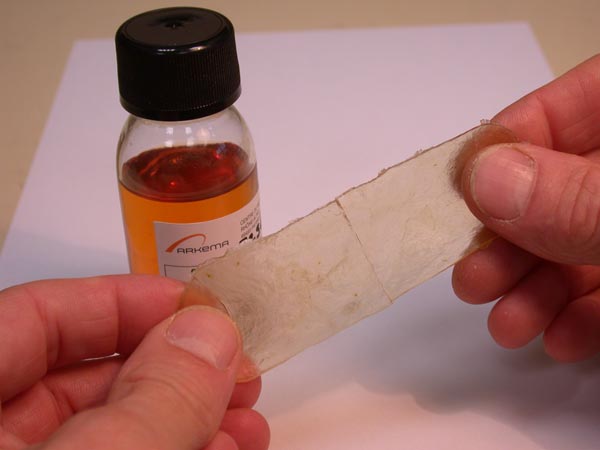What is Ferrofluid ?
A ferrofluid (portmanteau of ferromagnetic, and fluid) is a liquid which becomes strongly magnetized in the presence of a magnetic field. Ferrofluids are colloidal liquids made of nanoscale ferromagnetic, or ferrimagnetic, particles suspended in a carrier fluid (usually an organic solvent or water).
Ferrofluid
Each tiny particle is thoroughly coated with a surfactant to inhibit clumping. Large ferromagnetic particles can be ripped out of the homogeneous colloidal mixture, forming a separate clump of magnetic dust when exposed to strong magnetic fields. The magnetic attraction of nanoparticles is weak enough that the surfactant’s Van der Waals force is sufficient to prevent magnetic clumping or agglomeration. Ferrofluids usually do not retain magnetization in the absence of an externally applied field and thus are often classified as “superparamagnets” rather than ferromagnets.
The difference between ferrofluids and magnetorheological fluids (MR fluids) is the size of the particles. The particles in a ferrofluid primarily consist of nanoparticles which are suspended by Brownian motion and generally will not settle under normal conditions. MR fluid particles primarily consist of micrometre-scale particles which are too heavy for Brownian motion to keep them suspended, and thus will settle over time because of the inherent density difference between the particle and its carrier fluid. These two fluids have very different applications as a result.
A ferrofluid is a liquid which becomes strongly magnetized in the presence of a magnetic field
Ferrofluids are composed of nanoscale particles (diameter usually 10 nanometers or less) of magnetite, hematite or some other compound containing iron. This is small enough for thermal agitation to disperse them evenly within a carrier fluid, and for them to contribute to the overall magnetic response of the fluid. This is analogous to the way that the ions in an aqueous paramagnetic salt solution (such as an aqueous solution of copper(II) sulfate or manganese(II) chloride) make the solution paramagnetic.
Ferrofluids usually as “superparamagnets” rather than ferromagnets
Particles in ferrofluids are dispersed in a liquid, often using a surfactant, and thus ferrofluids are colloidal suspensions – materials with properties of more than one state of matter. In this case, the two states of matter are the solid metal and liquid it is in. This ability to change phases with the application of a magnetic field allows them to be used as seals, lubricants, and may open up further applications in future nanoelectromechanical systems.
True ferrofluids are stable. This means that the solid particles do not agglomerate or phase separate even in extremely strong magnetic fields. However, the surfactant tends to break down over time (a few years), and eventually the nano-particles will agglomerate, and they will separate out and no longer contribute to the fluid’s magnetic response.
Applications of Ferrofluid
Electronic devices
Ferrofluids are used to form liquid seals around the spinning drive shafts in hard disks. The rotating shaft is surrounded by magnets. A small amount of ferrofluid, placed in the gap between the magnet and the shaft, will be held in place by its attraction to the magnet. The fluid of magnetic particles forms a barrier which prevents debris from entering the interior of the hard drive. According to engineers at Ferrotec, ferrofluid seals on rotating shafts typically withstand 3 to 4 psi, additional seals can be stacked to form assemblies capable of higher pressures.
Mechanical engineering
Ferrofluids have friction-reducing capabilities. If applied to the surface of a strong enough magnet, such as one made of NdFeB, it can cause the magnet to glide across smooth surfaces with minimal resistance.
Aerospace
NASA has experimented using ferrofluids in a closed loop as the basis for a spacecraft’s attitude control system. A magnetic field is applied to a loop of ferrofluid to change the angular momentum and influence the rotation of the spacecraft.
Analytical instrumentation
Ferrofluids have numerous optical applications because of their refractive properties; that is, each grain, a micromagnet, reflects light. These applications include measuring specific viscosity of a liquid placed between a polarizer and an analyzer, illuminated by a helium-neon laser.
Medicine
In medicine, ferrofluids are used as contrast agents for magnetic resonance imaging and can be used for cancer detection. The ferrofluids are in this case composed of iron oxide nanoparticles and called SPION, for “Superparamagnetic Iron Oxide Nanoparticles”
There is also much experimentation with the use of ferrofluids in an experimental cancer treatment called magnetic hyperthermia. It is based on the fact that a ferrofluid placed in an alternating magnetic field releases heat.
Heat transfer
An external magnetic field imposed on a ferrofluid with varying susceptibility (e.g., because of a temperature gradient) results in a nonuniform magnetic body force, which leads to a form of heat transfer called thermomagnetic convection. This form of heat transfer can be useful when conventional convection heat transfer is inadequate; e.g., in miniature microscale devices or under reduced gravity conditions.
Optics
Research is under way to create an adaptive optics shape-shifting magnetic mirror from ferrofluid for Earth-based astronomical telescopes. Optical filters are used to select different wavelengths of light. The replacement of filters is cumbersome, especially when the wavelength is changed continuously with tunable type of lasers. Optical filters, tunable for differing wavelengths by varying the magnetic field can be built using ferrofluid emulsion.
Art
Some art and science museums have special devices on display that use magnets to make ferrofluids move around specially shaped surfaces in a fountain show-like fashion to entertain guests. Sachiko Kodama is known for her ferrofluid art. The Australian electronic rock band, Pendulum, used ferrofluid for the music video for the track, Watercolour. The design house Krafted London was responsible for the ferrofluid FX in the video. The post-metal band Isis also uses a Ferrofluid in the music-video for 20 Minutes/40 Years.
You might also like
| Smart Materials What are Smart Materials ? Smart materials are... | Smart Materials : Self-Healing Materials What is Self-Healing Material? Self-healing... | Smart Materials : Dielectric Elastomers What is Dielectric Elastomers ? Dielectric... | Transport Phenomena What is Transport Phenomena ? In engineering... |


 Alloy Suppliers
Alloy Suppliers
 Aluminum
Aluminum
 Aluminum Extrusions
Aluminum Extrusions
 Copper-Brass-Bronze
Copper-Brass-Bronze
 Nickel
Nickel
 Magnets
Magnets
 Stainless Steel
Stainless Steel
 Stainless Steel Tubing
Stainless Steel Tubing
 Steel Service Centers
Steel Service Centers
 Titanium
Titanium
 Tungsten
Tungsten
 Wire Rope
Wire Rope